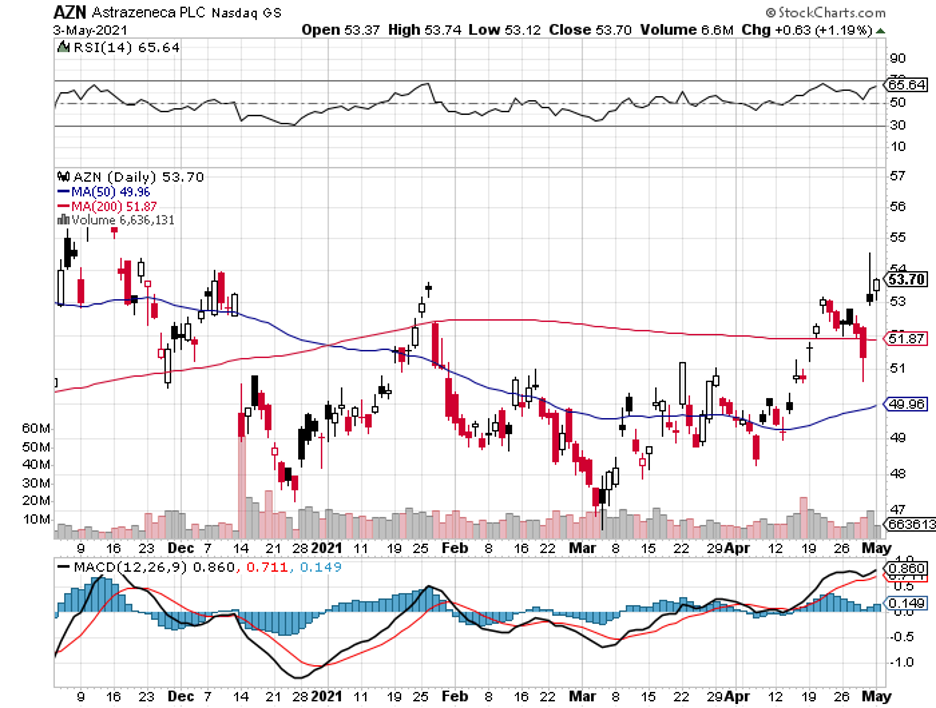Along with Pfizer (PFE), BioNTech (BNTX), and Moderna (MRNA), one of the biggest potential winners in the COVID-19 vaccine race is AstraZeneca (AZN).
While the company did manage to develop a vaccine nearly as fast as the others, its product is now suffering the same fate as Johnson & Johnson’s (JNJ) candidate and is getting bogged down by blood clotting issues.
As if that isn’t enough, AstraZeneca’s plan to use its diabetes drug Farxiga as another potential COVID-19 treatment also flopped.
Needless to say, it looks like not a lot of things are going well for AstraZeneca in the past months.
Looking at its fundamentals though, it’s worth noting that AstraZeneca stock might just be one of those rare prime candidates for being bad news buys.
After all, the company never really had plans to profit from its COVID-19 vaccine venture. In fact, AstraZeneca has long announced that it would sell its vaccine at cost. Hence, any bad news from the vaccine won’t really affect the company’s sales.
For years, AstraZeneca has been focused on creating a hyper-growth product lineup in several of the pharmaceutical industry’s most profitable submarkets.
In fact, the Phase 3 advanced pipeline candidates of the company are some of the most promising candidates in the industry, with these soon-to-be-launched drugs already generating 24% growth in revenue as early as 2017.
Not including cancer, there are at least 2.1 billion people globally who suffer from various chronic diseases. That accounts for over 25% of the entire human population, thereby representing a massive and lucrative addressable market--the very same market that AstraZeneca has been targeting.
In the years to come, AstraZeneca is projected to release at least six blockbuster drugs—each one of them estimated to rake in more than $1.3 billion in sales annually.
At the moment, one of the company’s major growth drivers is its oncology franchise, which has an early-stage pipeline anticipated to rake in roughly $1.3 billion each year by 2026.
In particular, AstraZeneca’s recently released cancer drugs Imfinzi and Tagrisso are well-positioned to dominate the segment thanks to their leading efficacy when it comes to hard-to-treat cancer types.
Meanwhile, other sub-sectors are expected to contribute $2.65 billion annually.
So far, AstraZeneca operates in more than 70 countries, ensuring its presence in practically all potential addressable markets.
In China alone, the company’s new product sales have risen by 68%, while the rest of the emerging markets recorded 56% growth.
Despite the negative publicity of its COVID-19 vaccine recently, AstraZeneca still managed to report positive data for its first quarter earnings.
Within this period, the company generated $7.2 billion in revenue, which is 15% more than its earnings during the same time last year. Its earnings per share rose by 100% to reach $1.19, while its core earnings were up 55%.
This is a welcome surprise, especially since analysts predicted $0.75 per share for the company.
The rise in AstraZeneca’s stock performance was driven mostly by its best-selling drugs, including Tagrisso with $1.15 billion in sales in the first quarter of 2021 alone and showing off a 17% jump year-over-year.
Even with the failed COVID-19 treatment, the diabetes drug Fargixa soared this quarter with $625 million, indicating a 54% increase from its previous performance during the same period.
More importantly, AstraZeneca has been consistently paying investors a dividend since it started doing it 20 years ago—a trend that’s expected to continue since the company is poised to become one of the fastest growing businesses in the world with 15% growth annually.
Given its pipeline programs and current portfolio of products, AstraZeneca is on track to continue its hypergrowth through 2023. At this pace, we can expect an estimated 105% in total returns and compound annual growth rate returns at 30.2%.
Currently, AstraZeneca stock is experiencing some turbulence due to the bad news linked to its COVID-19 vaccine. Now would be the best time to buy the dips on the bad news.


